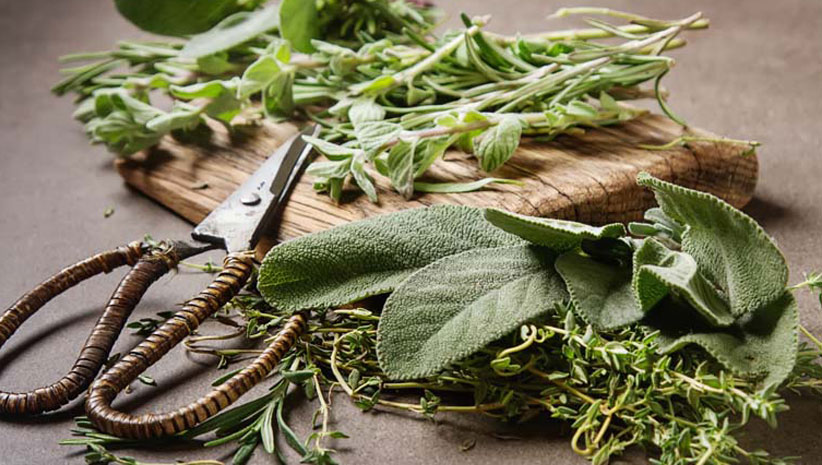
Cooking with fresh herbs can help warm us from the inside, which is particularly helpful in on damp, rainy days, or in the midst of the early spring season. Fresh herbs can make what we think of as comfort foods more easily digestible and actually comfortable for the body, and not only our cravings.
According to Ayurveda, the late winter and early spring seasons are associated with the kapha dosha (the water and earth elements). To counteract the heaviness that can come up this time of year, we can all benefit from warming foods that are also grounding as well as full of fresh prana, or life-force. There are several ways in which we can add an element of freshness to a hearty, heart-warming dish and one of the easiest (and tastiest!) ways to do this is by cooking with fresh herbs.
While there are tons of herbs we can use to elevate our cooking, three herbs that belong in any chef’s kitchen are oregano, rosemary, and thyme. These three herbs are easy for any herb novice to grow, even in a window box or outdoor kitchen garden in a variety of conditions. They are botanically related to mint, making them hearty plants that easily take root. Of course if you didn’t have them growing at home, these are so common that you will be able to find them fresh at farmers markets, grocery stores, and even farm delivery services. Because they are full of aromatic compounds that boost flavor, these culinary gifts also have health benefits.
Dried herbs are great to keep on hand as well, just keep track of the “best by” dates and make sure to rotate what is in our cabinet. Use smaller amounts of dried herbs in recipes.
Oregano
Oregano in Italian food is a surefire way to feel warm and comforted. Take any of your basic Mediterranean dishes to the next level by adding a teaspoon or two of fresh chopped oregano. Beyond Italian, oregano is a zippy addition to salad dressings and sauces or even chopped finely and tossed into a Greek or Italian salad for a flavor explosion. Creamy cauliflower au gratin? Throw in a scant tablespoon of fresh oregano to take it to the next level.
Health benefits include: contains antibacterial and antimicrobial properties, boosts the immune system and metabolism, and offers a dose of omega 3 fatty acids.
Rosemary
The smell of rosemary has the power to transport you into a comforting home kitchen. Try finely chopping fresh rosemary and tossing it with roasted potatoes, sweet potatoes, or any other root vegetable for a soul-soothing treat. This is also a great addition to soups, sauces, breads, and more. When roasting with veggies simply remove the leaves from the steam of one or two sprigs and chop finely; for simmering in a stew or even a sauce to infuse flavor throw in a couple whole sprigs and allow to steep a bit, then discard.
Health benefits include: Rosemary is a cognitive stimulant believed to improve memory and combat dementia; it boosts the immune system, stimulates blood flow, freshens breath, and soothes stomach pain.
Thyme
Who doesn’t need more thyme in their lives? This should be in every home cooks kitchen, especially for its warming effects during the cold, rainy, or damp winter and spring months. This herb is the perfect addition to soups, stews, roasted vegetables, risottos, pastas, breads, salad dressings, and so much more. Easily remove the leaves from the stem by running your fingers down the sprig while gripping firmly.
Use thyme sparingly as it has a strong flavor. Depending on the size of your recipe, a teaspoon or so should be enough when finely chopped, but these leaves are small and can be used un-chopped; entire sprigs of thyme can also be simmered whole (great in stocks, soups, and stews) and then discarded.
Health benefits include: high antioxidant content, improves circulation, support heart health, strengthen your immune system as well as support vision because it is rich in carotenoids which are the precursors to Vitamin A in the body.
Once you start cooking with fresh herbs, keep experimenting. The next time you are roasting a batch of potatoes, chopping a salad, or even baking a loaf of bread, two minutes of washing and chopping some fresh herbs will improve whatever dish you are making. Using fresh herbs and better yet—growing your own—proves you don’t need to be a master chef to cook like one.
Creamy Miso-Thyme Dressing
This dressing is good on just about anything; served as a dip for raw veggies, baked zucchini or breads, drizzled over warm baked sweet potatoes, tossed in a pasta salad, or massaged into a kale salad.
Ingredients
1/2 cup organic grapeseed oil
1/4 cup water
4 tablespoons lemon juice
3 peeled garlic cloves
3 tablespoons white miso paste
2 scant teaspoons fresh thyme leaves, stems discarded
fresh cracked pepper to taste
Place all of the ingredients in a blender and blend until smooth and creamy. Adjust your seasonings to taste as you may want more miso, thyme, lemon or pepper. It should come out on the thicker side for a dressing but feel free to add in more water to thin it out to desired consistency. This can be stored well in an air-tight container in the fridge for seven days.
Kayla Rose Freudenberg is a yoga teacher and plant-based chef based in Orange County who believes that optimal health is an achievable goal for everyone. Kayla combines the principles of yoga, mindfulness, and nourishing food to guide and maintain the well-being of her students and clients.
